| These highlights chronicle the year 2016. Created
incrementally as new photos were available, the year runs generally
"backwards" on this page. The abbreviation "MTY" means "Monterey County"
in the text below. Text by Don Roberson. Photos on this page
are copyrighted by the photographers to whom they are
attributed, and may not be reproduced in any form (including
other web sites) without the express consent of the photographer. |
|
The
Monterey Peninsula Christmas Bird Count (CBC) on 28 Dec wrapped up the
year 2016. It was an exceptionally fine count for rarities, including
the amazing flock of 8 geese on a Pebble Beach golf course discovered
that day. This photo, taken the next day, shows six of them (L to R): a
Ross's Goose, a blue-morph Snow Goose, then two white-morph Snow Goose (the 3rd and 5th bird), and two apparent Snow X Ross's hybrids/intergrades
(the 4th & 6th birds; two more Snow Geese, one of them an immature,
are not shown in the photo from 29 Dec © D. Roberson). The two
apparent hybrids were intermediate in size and bill length and details.
We've had a few MTY records of hybrid before; I wrote a paper on the
i.d. problem some years ago [Roberson 1993] that included some prior
MTY records. The blue-morph Snow Goose is very unusual. The only prior
documented record was one that summered at Crespi Pond on Pt. Pinos
from 5 June-19 July 2012 [see photos in a prior update].
The bird in Pebble Beach now is our first documented record of this
morph in winter in MTY. It is rare to California — it is much more
common in the East.
A boat trip for the CBC had a good
variety of normal pelagics, but very high numbers of Ancient Murrelet
(over 400). That, together with the rarities shown here, and good
coverage of the 15 mile diameter circle (18 territories covered,
coordinated by Rita Carratello), combined for a tentative total of 187 species (subject to confirmation of rarer birds). That's a significantly higher total than we've had in recent years.
|
One excellent rarity was a full-gorgetted male Costa's Hummingbird
at the Monarch Grove Sanctuary in Pacific Grove (photo near right
© Robert Shields). It was only seen that day and the next morning,
and not refound since. A female was a few blocks away from 3-15 January
of this year [see photo in a prior update] but any Costa's in winter on the Monterey Peninsula is unusual.
The same vicinity also had the continuing male Summer Tanager, now present for its 4th winter [it arrived in October this fall; photo from 22 Dec © Blake Matheson]. |
|
|
|
| Yet
perhaps the most spectacular part of this year's CBC was the sheer
number of vagrant passerines at Laguna Grande Park that remained
through 28 Dec. All had been previously discovered in Nov-early Dec
(details below) but several represent remarkable winter records. These
six were photographed on the CBC itself (all 28 Dec © D.
Roberson): Black-and-white Warbler (top row in panel below), Yellow-breasted Chat and Black-throated Green Warbler (second row), and Lucy's Warbler, Nashville Warbler, and White-throated Sparrow
(bottom row). The Yellow-breasted Chat is the first for any local CBC
and one of the very few to occur in northern California in winter; also
note that its tail has grown in [farther down the page you'll find
photos with its tail in molt]. The Black-throated Green Warbler is only
the second to winter locally. Lucy's Warbler has more of a history in
winter in MTY — this appears to be the 14th winter record for the
county — but none have been very recent. The last one present in winter
was 16-29 Dec 2001 in Caledonia Park, Pacific Grove. Both Nashville
Warbler and White-throated Sparrows winter in very small numbers
locally, but their presence added to the Laguna Grande smorgasbord this
year. |
|
This year an adult Long-tailed Duck
appeared in Roberts Lake in late November and re-appeared several times
to bathe in fresh water. It was seen to fly across Hwy 1 to the ocean,
though, and spent most of its time at sea. Kent Van Vuren photographed
it on Roberts Lake on 25 Nov (upper photo below). We now been advised
by Peter Pyle, via Dan Singer, that this bird was an adult female. Kent
also photographed a Long-tailed Duck in Monterey harbor on 16 Dec
(lower photo below; both © K. Van Vuren). Pyle, through Singer,
states this second duck is a first-year male. Bill color helps separate
sexes but I am at a loss in understanding plumages and molt. Robertson
& Savard (2002) state that "Unlike other waterfowl, [it] has 3
plumages/year (Basic, Supplemental, Alternate), the first 2 of which
are acquired at 2 different stages. As a result, plumage is in almost
continuous change between spring and fall." Ageing Long-tailed Duck
appears very complex to me (and, obviously, my initial thoughts these
were the same birds in different states of molt was way off). |
|
|
|
| On 20 Dec, an odd warbler photo'd at Laguna Grande by Don Glasco proved to be an imm Black-throated Green Warbler
(near right 21 Dec © Bill Hill, far right 20 Dec © D.
Roberson). Another Black-throated Green wintered in this park from Dec
2002-Feb 2003. We hope this one may do the same! |
|
|
|
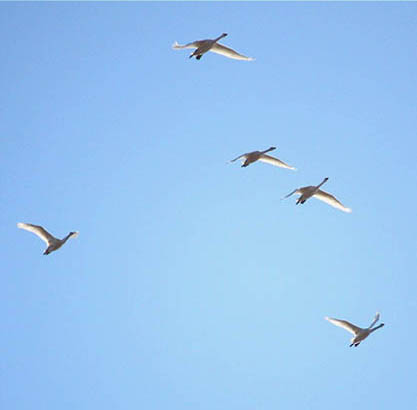 |
Interesting December finds included a flock of six Tundra Swans
that landed in Estrada Marsh, adjacent to Elkhorn Slough, on 2 Dec
(left © Rita Carratello; 5 of 6 appear in this photo; the 6th was
cropped out to fit the format). Another Tundra Swan was at Carmel R.
mouth 18-19 Dec (B.L. Sullivan, M. Rieser +).
On
14 Dec, Brian Sullivan & Paul Fenwick encountered this
juvenal-plumaged gull at the Marina landfill (right, © B.L.
Sullivan; it was still present on 31 Dec). It showed many characters of
"Kumlien's Gull," the North American breeding taxa of Iceland Gull.
Such gulls are invariably controversial in some circles but this
appeared to be an excellent candidate. Most experts with substantial
East Coast experience agree. |
|
|
The
MAS Pt. Pinos Seawatch concluded with an "extra day" on 16 Dec — a day
of high winds rather than the rain and gloom on 15 Dec — providing a
full six weeks of dawn-to-dusk seawatching coverage at the Point. This
Seawatch tallied nearly a million birds (over 957,500) that are now
documented in 490 eBird checklists.
We saluted our official counters — Mark Kudrav & Skye Haas
[identified by big yellow arrows in the photo below, © Rita
Carratello], along with a dozen Monterey Audubon volunteers — just
after sunset one day that final week. The effects of sun and sea are
apparent, not to mention pizza & beer.
|
Among the highlights of those six weeks of seawatching were:
- 276,472 Pacific Loon
- 94,728 Red Phalarope
- 44,434 Surf Scoter
- 31,168 Brown Pelican
- 265 Short-tailed Shearwater
- 50 Leach's Storm-petrel [46 on the final day, 16 Dec]
- and such rarities as 9 Manx Shearwater, 2 Brown Booby, a Nazca Booby and a Great Frigatebird [details further below]
|
|
|
| A green swatch of blackberry and willow thickets, overlain with yellow-flowering English ivy, in Laguna Grande Park
became the center of attention in late November. The spot (middle photo
below, left column) is part of what birders call "the Virgin Patch," as
it is just west of the parking area for Laguna Grande on Virgin Avenue.
This particular spot — where Bill Hill is set up with his camera in the
western end of the Virgin Patch, where new trails with chipped-wood
walking surface now exist — has become known as the "chat patch." On 20 November, Steve Rovell found this Yellow-breasted Chat
(below left, © Steve Rovell ), the first ever in MTY in November
and the second-latest fall record. The chat was very elusive most of
the time, apparently buried deep in blackberry thickets in front of
Bill, but occasionally popping out to feed. It took many birders much
time to see it. Visiting birder Dave Weber spotted a small gray warbler
there on 22 Nov, confirmed shortly thereafter by Michael Rieser and
Carole Rose as a Lucy's Warbler, to add to the allure
of this location (top two photos in righthand column, both taken 23 Nov
© Bill Hill). The chestnut rump patch, which shows on Bill's
flight shot, was its best character. |
|
|
It was also in this same thicket that Don Roberson had found a very elusive Virginia's Warbler
back on 22 October (just above, righthand column, with bird
half-obscured © D. Roberson). Both Virginia's and Lucy's Warbler
are rare vagrants from southwestern U.S. or Mexico — we average only
about one a year of each.
By 25 November, the Yellow-breasted Chat
was on its 6th day of presence, and now we can see why in this photo
(just above, lefthand column, photo 23 Nov © D. Roberson). The
chat is in active tail-molt, with an old and battered and faded outer
rectrices still present and fresh, new inner rectrices growing in.
Until the tail grows in, the chat will be in no condition to continue
its flight south to the Neotropics.
In the
photo just above the bill is stained red with berry juice, but the fact
that the bill was pinkish-brown, the lores are dark gray, and (perhaps)
the fact it was not heard to utter any sound suggest it is a female,
and the tail molt suggests an second-year or an adult female. The wide
white malar stripe, which extends well back behind the eye and
separates the gray head from yellow breast, and the gray (not green)
tone of the upperparts, suggest it is of the western race auricollis [these details per Pyle 1997]. |
|
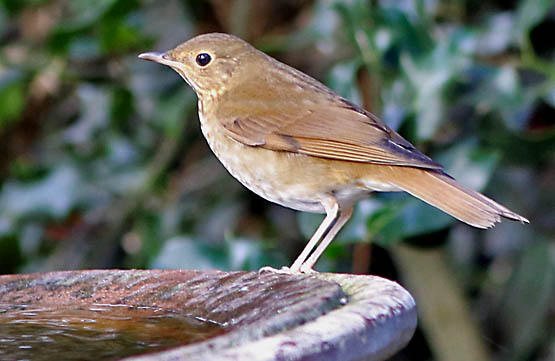 Another exceptional late fall migrant was this Swainson's Thrush
in a Pacific Grove backyard from 5-9 November (photo right, 6 Nov
© Don Roberson). It edged out another Swainson's Thrush banded at
Big Sur Ornithology Lab on 8 Nov 1997. Both Don Roberson and Rita
Carratello heard the Pacific Grove thrush calling in their yard at dusk
each evening through 9 November. In a nice ironic twist of fate, Rita
had banded the BSOL thrush on 8 Nov 1997, 19 years previously. Another exceptional late fall migrant was this Swainson's Thrush
in a Pacific Grove backyard from 5-9 November (photo right, 6 Nov
© Don Roberson). It edged out another Swainson's Thrush banded at
Big Sur Ornithology Lab on 8 Nov 1997. Both Don Roberson and Rita
Carratello heard the Pacific Grove thrush calling in their yard at dusk
each evening through 9 November. In a nice ironic twist of fate, Rita
had banded the BSOL thrush on 8 Nov 1997, 19 years previously.
Also
this fall, the male Summer Tanager that wintered in the vicinity of
Rita and Don's Pacific Grove yard for the last 3 winters returned to
the same vicinity on 21 Oct this fall (Blake Matheson) and appears to
be wintering again for its 4th year. It was initially discovered in
March 2014 as a first-winter male, and returned as a full red male
between 6 Oct 2014–6 Apr 2015 and last year from 21 Oct 2015–21 Apr
2016. Each year it has flown a route as far south as Asilomar and north
to the Pacific Grove ballpark. It has already made its appearance at
Asilomar this fall (Amanda Preece). |
| The
Monterey Audubon Pt. Pinos Seawatch continues apace through its
half-way point, tallying up hundreds of thousands of Black-vented
Shearwaters and Red Phalaropes in November. I've superimposed my shot
of 21 Surf Scoters in the sky (below) — these had already been
clicked-off by our counters Mark Kudrav (below left) and Skye Haas
[below right; more on the Seawatch farther down this page]. Rarities in
November included a juvenal-plumaged Pomarine Jaeger
(right, photo 17 Nov © Brian L. Sullivan; this plumage is very
rarely documented in California), a Flesh-footed Shearwater, a couple
Manx Shearwater, and a late Buller's Shearwater. |
|
|
Certainly the most spectacular rarity to pass the Seawatch after the Great Frigatebird (see below) was an adult Nazca Booby on 14 Nov — seen by Skye Haas, Paul Fenwick, and Blake Matheson. This is the 4th for MTY; all of them this year!
Meanwhile, just across the street in cypresses on Pt. Pinos, visiting Fresno birder Gary Woods discovered a calling Dusky-capped Flycatcher
(below, photo 14 Nov © Gary Woods). It was cooperative and seen by
many during its visit from 14-16 Nov. This is the 9th record for MTY,
all in late fall or winter. The most recent was in Pacific Grove's El
Carmelo Cemetery from 16-19 Nov 2013. |
|
|
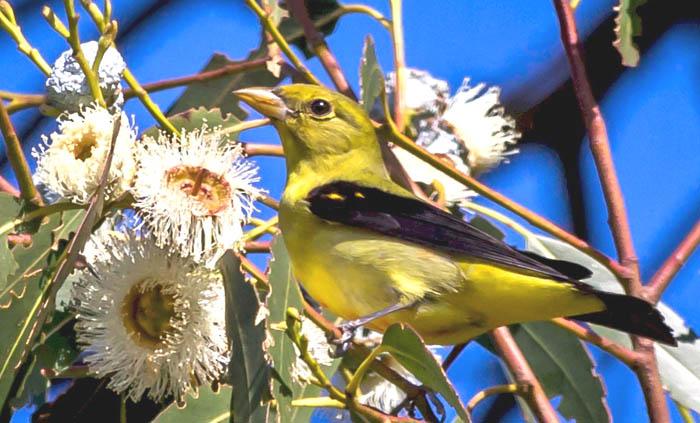 |
On 13 Nov, Steve Rovell and Larry & Carole Rose discovered an adult male Scarlet Tanager
at Monterey's San Carlos Cemetery (left, photo 15 Nov © Carole
Rose). This exciting vagrant was also cooperative through 16 Nov, and
was successfully chased by many interested observers.
This
is the 6th MTY record, and the first in November. All prior records had
been in October. One of them (11-17 Oct 1987) had been an adult male
with yellow body and black wings and tail. Of the 126 Scarlet Tanagers
accepted by the CBRC through 2003, only 4 were adult males in fall
migration. |
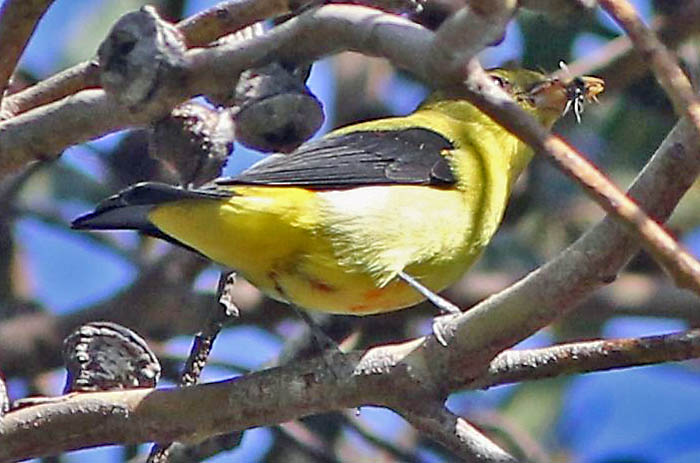 |
This
year's bird was interesting for several other reasons. For one, it had
a couple of red feathers in its otherwise all-black upperwing coverts
plus a smattering of orange-red feathers on its lower belly. These
might be retained from alternate plumage or might be a rare variant in
full winter plumage (Pyle 1997).
The tanager
was also actively catching small bees or wasps at eucalypt flowers; it
has just caught one in this shot (left, 13 Nov © Don Roberson).
We've seen vagrant Summer Tanagers eating bees locally, but this is the
first Scarlet to do so. |
|
| |
|
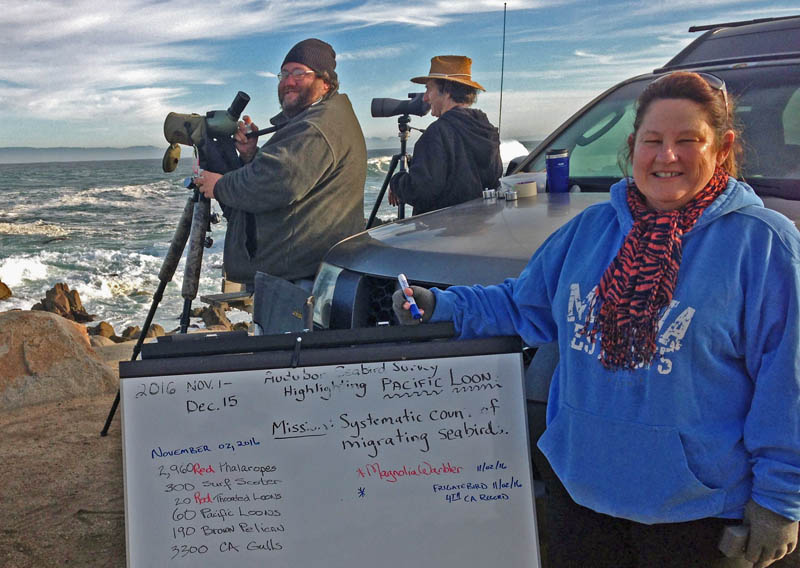 The Monterey Audubon Society's Pt. Pinos Seawatch
began again on 1 Nov 2016. Michigan notable Skye Haas (above, left) and
local Mark Kudrav (above center) will man the telescopes from
dawn-to-dusk for the next six weeks. Just as last year, local volunteer
spotters, such as Paul Fenwick (above right) will lend a hand whenever
time permits. The Monterey Audubon Society's Pt. Pinos Seawatch
began again on 1 Nov 2016. Michigan notable Skye Haas (above, left) and
local Mark Kudrav (above center) will man the telescopes from
dawn-to-dusk for the next six weeks. Just as last year, local volunteer
spotters, such as Paul Fenwick (above right) will lend a hand whenever
time permits.
Monterey Audubon has worked with
the P.G. Museum of Nat. Hist. to provide docents to help explain the
seawatch to visitors. Here (right) Connie Masotti sets up a placard
with recent counts and highlights [note Skye and volunteer Robert Horn
at the scopes behind].
On 1 Nov, Mark Kudrav saw
a male Harlequin Duck fly by with a scoter flock. At 4 p.m. on 2 Nov,
those at the seawatch had a cosmic, almost 'out-of-body,' experience. A
subadult frigatebird flew west past the Point! Skye Haas got off a
dozen photos (one of them below, 2 Nov © S. Haas): initial
literature and expert review indicates it was a 2d-or-3d cycle Great Frigatebird Fregata minor !! |
|
|
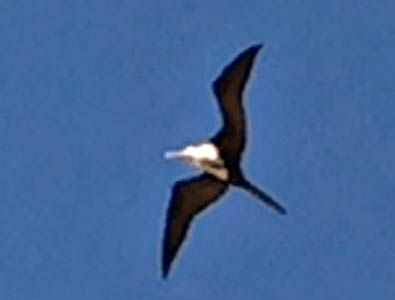 This
frigatebird was reported over Del Monte Beach at 2 p.m. on 2 Nov, and
photographed by Navy personnel Peter Gray (right, © P. Gray via
Todd Wills). Then it was reported by a Monterey Whalewatch boat heading
west. It sailed past Pt. Pinos in a cloud of gulls, turned the corner
and headed south, and then 'disappeared' despite much local effort to
relocate it. There are now indications it might have been seen over
Marina dump and Salinas R. mouth earlier (as of yet, no details of
these reports have arrived). Early reporters considered it a young
Magnificent Frigatebird. MTY has about 20 records of Magnificent, all
between July–September, from 'warm water' years and mostly from the
1970s. The most recent was in July 1998. This
frigatebird was reported over Del Monte Beach at 2 p.m. on 2 Nov, and
photographed by Navy personnel Peter Gray (right, © P. Gray via
Todd Wills). Then it was reported by a Monterey Whalewatch boat heading
west. It sailed past Pt. Pinos in a cloud of gulls, turned the corner
and headed south, and then 'disappeared' despite much local effort to
relocate it. There are now indications it might have been seen over
Marina dump and Salinas R. mouth earlier (as of yet, no details of
these reports have arrived). Early reporters considered it a young
Magnificent Frigatebird. MTY has about 20 records of Magnificent, all
between July–September, from 'warm water' years and mostly from the
1970s. The most recent was in July 1998.
Skye's good photos have been very helpful. The
white head, zigzag pattern of wedges along the sides and flanks, and
(especially) the rusty feathers to chin and upper breast appear to rule
out Magnificent Frigatebird (e.g., Howell 1994). There is one prior
record of Great Frigatebird
— a male over Salinas R. mouth on 13 Oct 1979 — which was the first for
California. An adult female Great visited the Farallones on 14 Mar
1992, and there is a 3 Nov 1975 record of an adult male in Oklahoma
(!). That's it for North America. If accepted by CBRC, this would be
just the 4th ABA record (Howell et al. 2014).
There are also four North American records of Lesser Frigatebird F. ariel,
including an imm female in Humboldt Co., CA, 15 July 2007. The others
are from July–September in Wyoming, Michigan, and Maine. Its plumages
somewhat resemble Great — including white head with rusty feathers —
but there are differences in overall size, bill length, axillary and
belly patterns (see James 2004). So far the Pt. Pinos frigate looks
good for Great, but we still await further expert analysis.
|
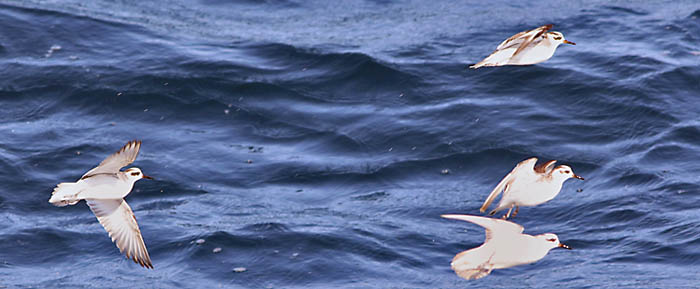 Meanwhile, back at the seawatch, the first 4 days piled up big numbers of Black-vented Shearwaters and, especially, Red Phalaropes
(right; photo from 23 Oct © D. Roberson). Tens of thousands have
been in Monterey Bay the last weeks of October and into November. Meanwhile, back at the seawatch, the first 4 days piled up big numbers of Black-vented Shearwaters and, especially, Red Phalaropes
(right; photo from 23 Oct © D. Roberson). Tens of thousands have
been in Monterey Bay the last weeks of October and into November.
On 2 Nov, Mark Kudrov checked the Pt. Pinos cypresses across the street from the seawatch, and discovered a vagrant Magnolia Warbler
(below left, photo 2 Nov © Paul Fenwick); it lingered a couple of
days. On 3 Nov, Brian Sullivan photographed an adult female Rough-legged Hawk
over Moonglow Dairy (below right, photo © B.L. Sullivan). It has
been years since MTY has had a decent winter flight of this striking Buteo; perhaps this is a precursor? |
|
|
Mid-October
brought a marvelous trifecta to MoonGlow Dairy near Moss Landing,
attracting crowds of birders there between 13-15 October. The stars
were:
- a male Black-throated Blue Warbler,
first discovered by Kent Van Vuren on 10 October (above left, upper
photo © D. Roberson). There are now about 25 records in MTY, all
in fall migration except for one that wintered at Quail Lodge in
1983-84. This eastern vagrant has become more difficult in recent
years; this is the first since a female was at Moonglow in Oct 2012.
Stunning males like this year's bird are particularly prized.
- a fine Prothonotary Warbler
on 13 Oct found by David Tomb and Rob Cullison in the morning and seen
by many late that afternoon; it appeared to be exhausted and went to
sleep (photo above right © Bill Hill). There are now about 20
records for MTY but this is the first for Moonglow Dairy.
- a juvenile Sharp-tailed Sandpiper
was discovered on pond #1 late in the afternoon of 13 Oct by Brian
Sullivan, and remained to at least 15 Oct (above left, second photo
© B.L. Sullivan, from a long distance). There are now about 30 MTY
records, all in fall migration, but numbers seem less now than before.
This is the first since two were present in fall 2013. However, this is
now the 8th Sharp-tailed to visit this small freshwater pond next to
tidal Elkhorn Slough.
Moonglow Dairy was also the best MTY locale earlier in September. Highlights from that month are below — up to three Chestnut-sided Warblers between 5–24 Sep, three on 17 Sep; a hatch-year female is shown below left (13 Sep © Carole Rose) — and a juvenile Swainson's Hawk
from 4–13 Sep, found by Blake Matheson, and shown here in photos from 5
Sep (on fence post © Rick Fournier) and in flight (below right, 13
Sep © Carole Rose). Another juv Swainson's Hawk was seen here on 1
Oct (D. Roberson, R. Carratello +)
|
|
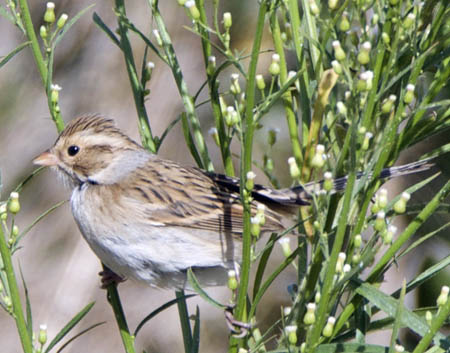 The
Soberanes Fire, which began on 22 July in Garrapata SP from an illegal
campfire, and dominated the news in late summer, was 'officially'
extinguished on 13 October after burning 132,127 acres of the Los
Padres NF. Many State Parks and all of the National Forest continued to
be closed into October. It will be interesting to see how birds
recolonize this huge area. The
Soberanes Fire, which began on 22 July in Garrapata SP from an illegal
campfire, and dominated the news in late summer, was 'officially'
extinguished on 13 October after burning 132,127 acres of the Los
Padres NF. Many State Parks and all of the National Forest continued to
be closed into October. It will be interesting to see how birds
recolonize this huge area.
With the loss of the Salinas
WTP as habit, and Andrew Molera SP closed, birding seemed quite
depressed during the early fall. Sunny skies and clear nights seemed to
have propelled migrants to fly over us. We had a few scattered Tropical
Kingbirds, a couple wayward White-winged Doves (P. Fenwick, R.
Carratello), about 5 or so Clay-colored Sparrows
(this one, right, found by Michael Rieser along South Bank trail,
Carmel Valley, 11 Oct; photo © Cooper Scollan), and a Brewer's
Sparrow at that locale the same date (D. Roberson).
Most impressive in early September was this adult Nazca Booby
photographed about 60 miles off Pt. Sur on 3 September (below ©
Robert Pitman). The molt pattern on wings seems to assure that it is a
different bird than that adult over Monterey Bay on 17 July (see prior Update). This is the third for MTY this year! It seems this Galapagos breeder is ranging northwards more regularly.
|
|
Literature cited on this page:
- Howell, S.N.G., I. Lewington, and W. Russell. Rare Birds of North America. 2014. Princeton Univ. Press, Princeton, N.J.
- Howell,
S. N. G. 1994. Magnificent and Great Frigatebirds in the eastern
Pacific: A new look at an old problem. Birding 26: 400-415.
- James, D. J. 2004. Identification of Christmas Island, Great and Lesser Frigatebirds. Birding Asia 1: 22-38.
- Pyle, P. 1997. Identification Guide to North American Birds, Part I. Slate Creek Press, Bolinas, CA.
- Roberson, D. 1993. A note on hybrid white geese. Birding 25: 50-53.
- Robertson,
G.J. and J-P.L. Savard. 2002. Long-tailed Duck (Clangula hyemalis), The
Birds of North America (P. G. Rodewald, Ed.). Ithaca: Cornell Lab of
Ornithology; Retrieved from the Birds of North America:
https://birdsna.org/Species-Account/bna/species/lotduc
|
|
TOP
GO TO
HOME PAGE
TO MONTEREY
COUNTY
PAGE
TO BIRD
FAMILIES
OF THE WORLD
|

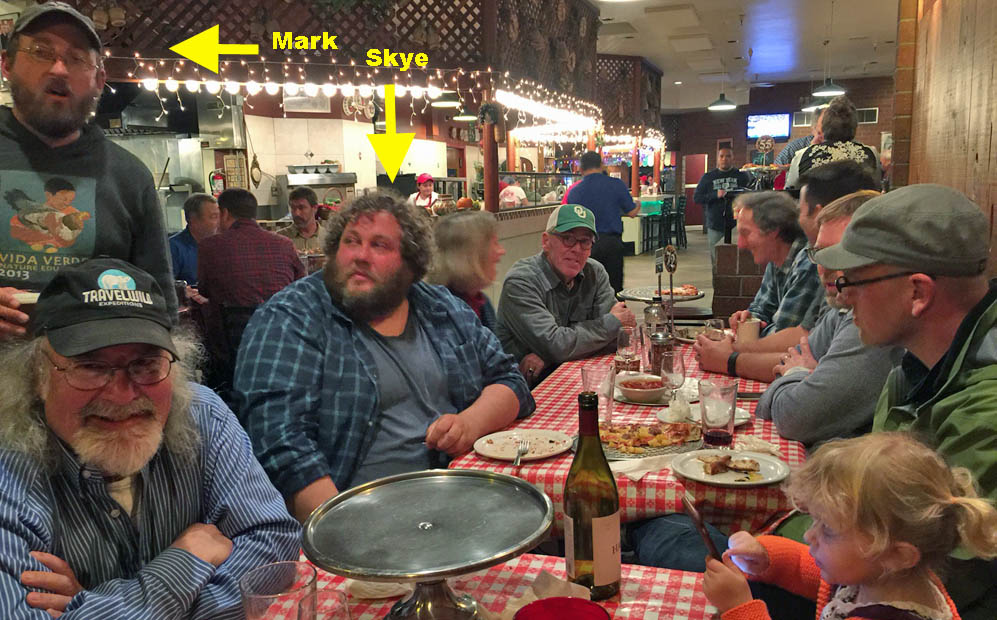
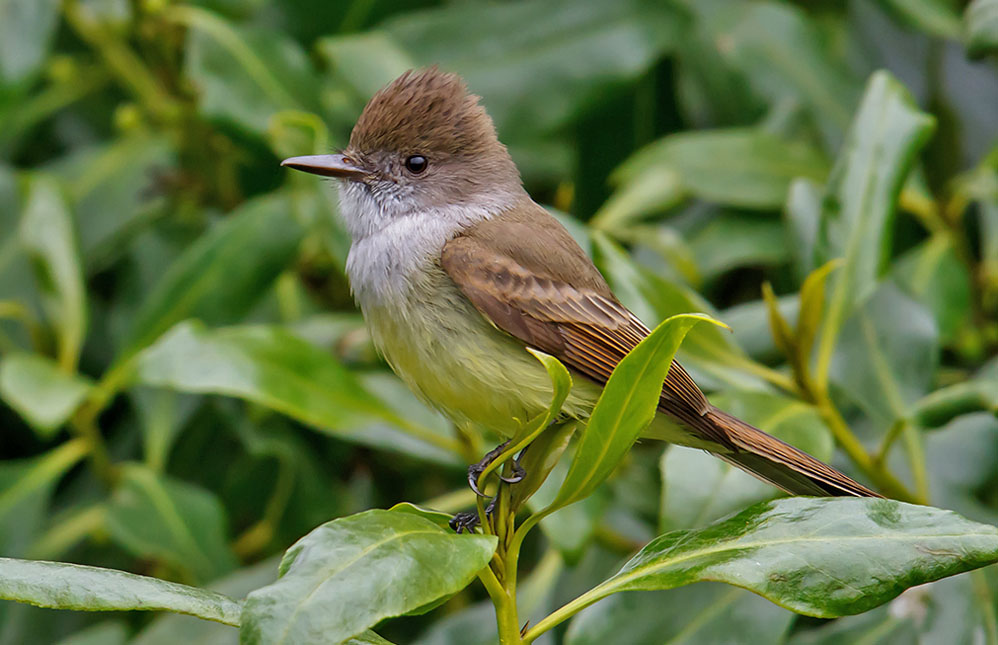

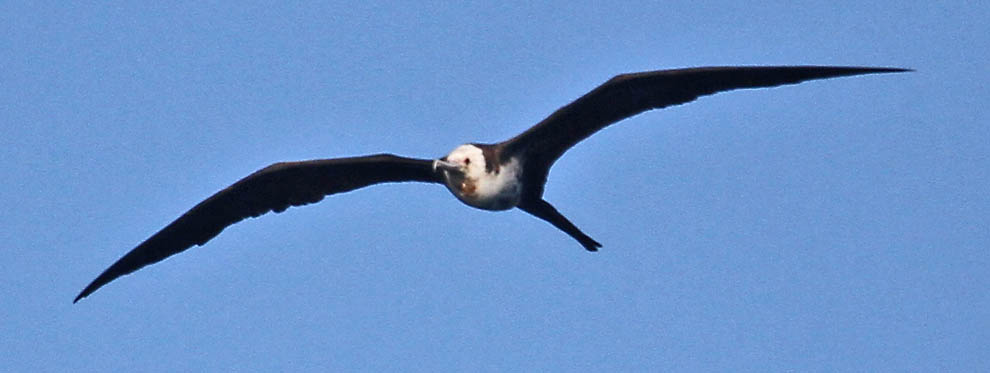
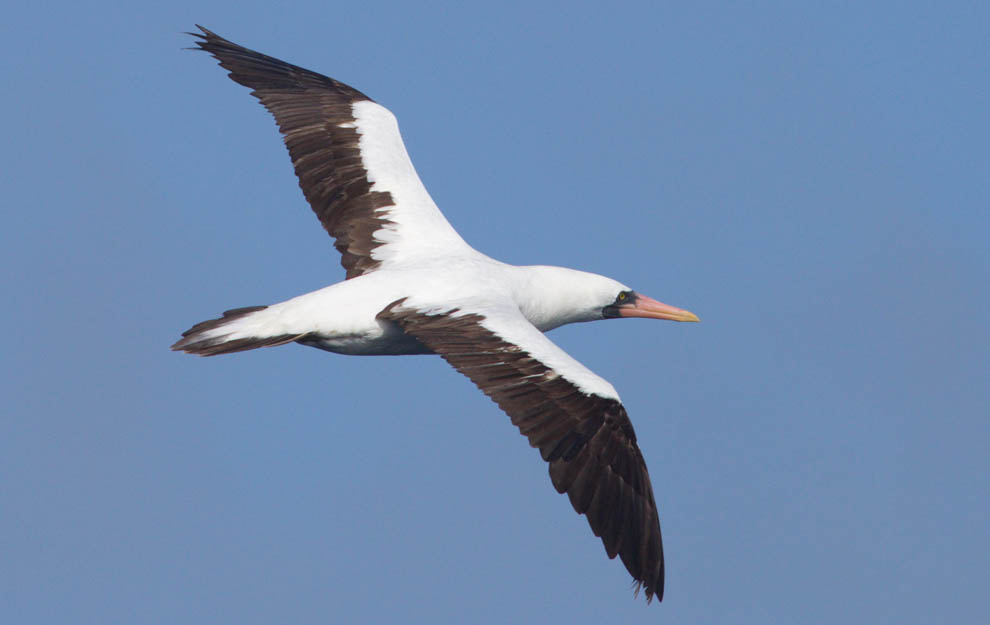
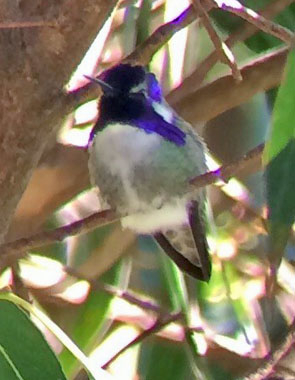
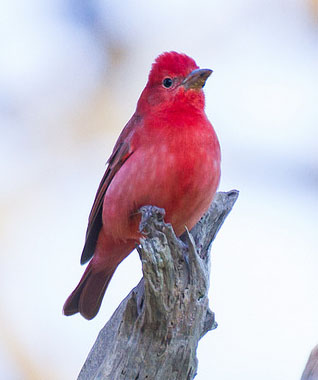

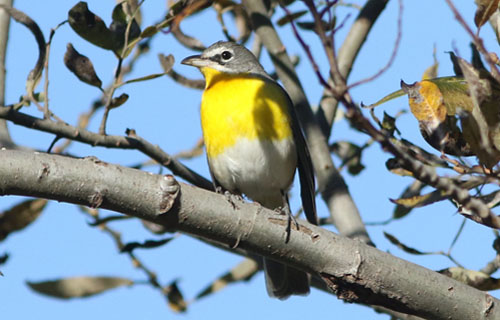
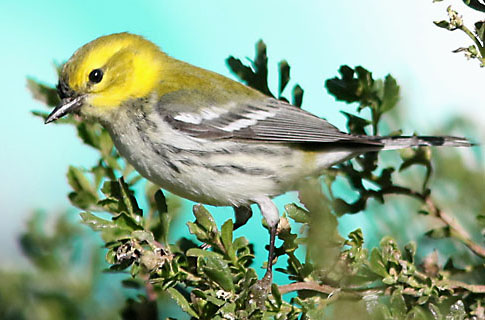
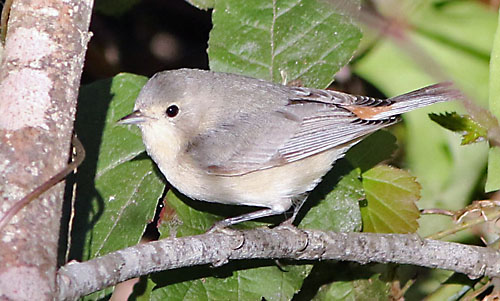
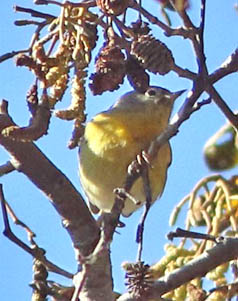
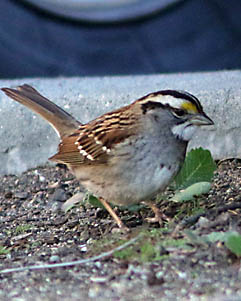
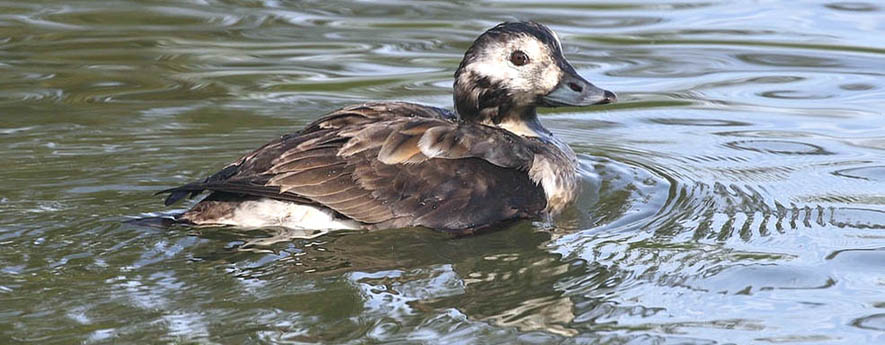
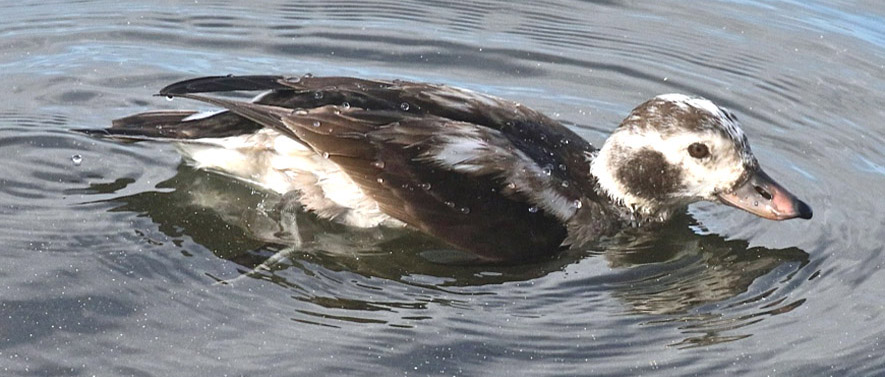
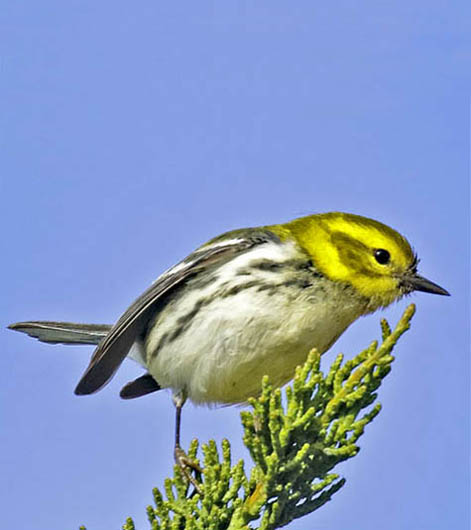
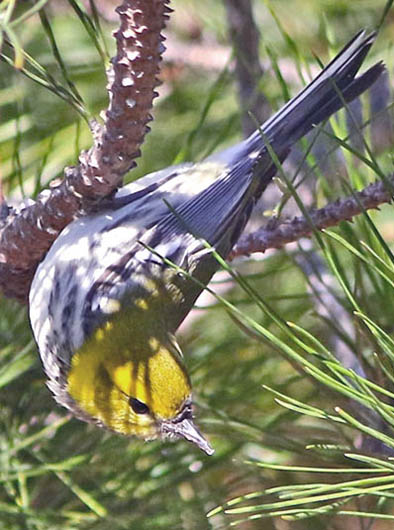

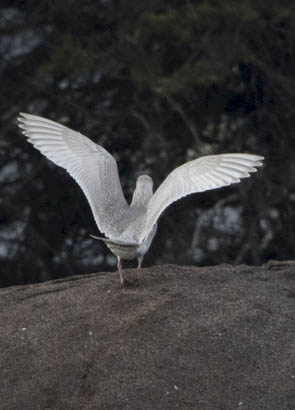
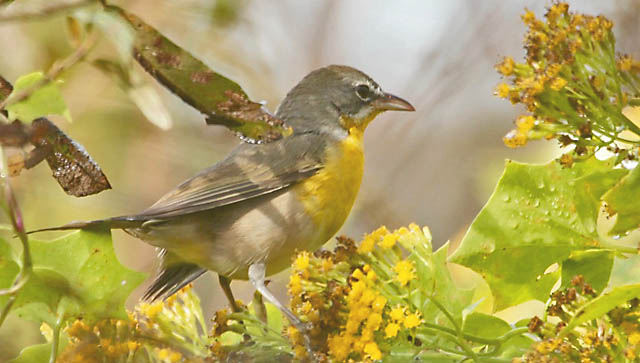
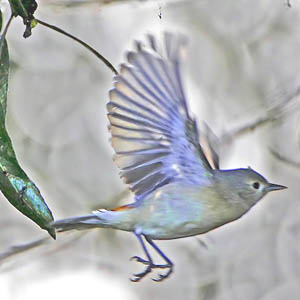
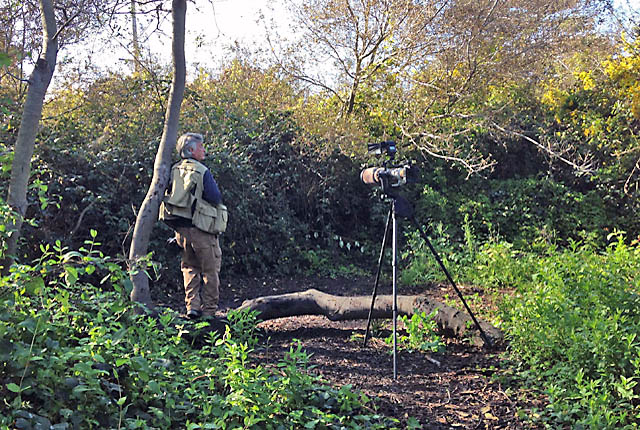
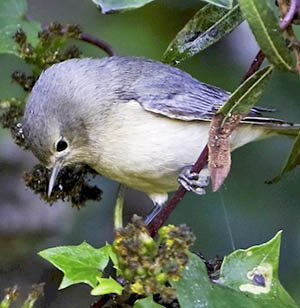
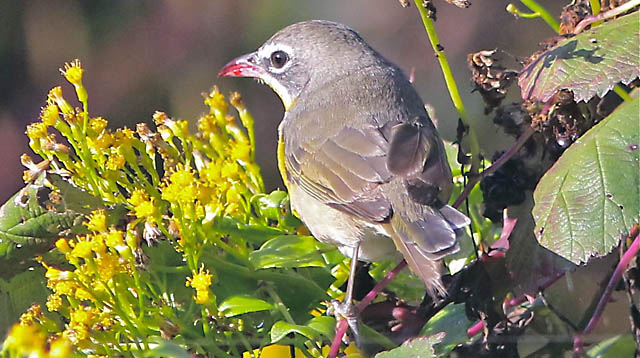
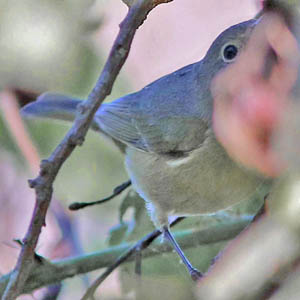
 Another exceptional late fall migrant was this Swainson's Thrush
in a Pacific Grove backyard from 5-9 November (photo right, 6 Nov
© Don Roberson). It edged out another Swainson's Thrush banded at
Big Sur Ornithology Lab on 8 Nov 1997. Both Don Roberson and Rita
Carratello heard the Pacific Grove thrush calling in their yard at dusk
each evening through 9 November. In a nice ironic twist of fate, Rita
had banded the BSOL thrush on 8 Nov 1997, 19 years previously.
Another exceptional late fall migrant was this Swainson's Thrush
in a Pacific Grove backyard from 5-9 November (photo right, 6 Nov
© Don Roberson). It edged out another Swainson's Thrush banded at
Big Sur Ornithology Lab on 8 Nov 1997. Both Don Roberson and Rita
Carratello heard the Pacific Grove thrush calling in their yard at dusk
each evening through 9 November. In a nice ironic twist of fate, Rita
had banded the BSOL thrush on 8 Nov 1997, 19 years previously. 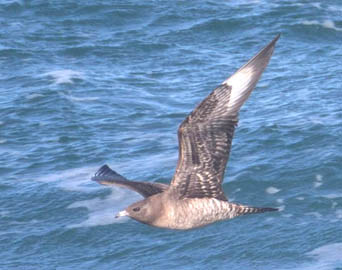
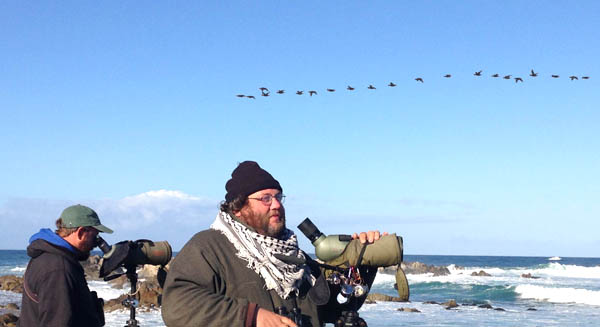


 The Monterey Audubon Society's Pt. Pinos Seawatch
began again on 1 Nov 2016. Michigan notable Skye Haas (above, left) and
local Mark Kudrav (above center) will man the telescopes from
dawn-to-dusk for the next six weeks. Just as last year, local volunteer
spotters, such as Paul Fenwick (above right) will lend a hand whenever
time permits.
The Monterey Audubon Society's Pt. Pinos Seawatch
began again on 1 Nov 2016. Michigan notable Skye Haas (above, left) and
local Mark Kudrav (above center) will man the telescopes from
dawn-to-dusk for the next six weeks. Just as last year, local volunteer
spotters, such as Paul Fenwick (above right) will lend a hand whenever
time permits. This
frigatebird was reported over Del Monte Beach at 2 p.m. on 2 Nov, and
photographed by Navy personnel Peter Gray (right, © P. Gray via
Todd Wills). Then it was reported by a Monterey Whalewatch boat heading
west. It sailed past Pt. Pinos in a cloud of gulls, turned the corner
and headed south, and then 'disappeared' despite much local effort to
relocate it. There are now indications it might have been seen over
Marina dump and Salinas R. mouth earlier (as of yet, no details of
these reports have arrived). Early reporters considered it a young
Magnificent Frigatebird. MTY has about 20 records of Magnificent, all
between July–September, from 'warm water' years and mostly from the
1970s. The most recent was in July 1998.
This
frigatebird was reported over Del Monte Beach at 2 p.m. on 2 Nov, and
photographed by Navy personnel Peter Gray (right, © P. Gray via
Todd Wills). Then it was reported by a Monterey Whalewatch boat heading
west. It sailed past Pt. Pinos in a cloud of gulls, turned the corner
and headed south, and then 'disappeared' despite much local effort to
relocate it. There are now indications it might have been seen over
Marina dump and Salinas R. mouth earlier (as of yet, no details of
these reports have arrived). Early reporters considered it a young
Magnificent Frigatebird. MTY has about 20 records of Magnificent, all
between July–September, from 'warm water' years and mostly from the
1970s. The most recent was in July 1998.  Meanwhile, back at the seawatch, the first 4 days piled up big numbers of Black-vented Shearwaters and, especially, Red Phalaropes
(right; photo from 23 Oct © D. Roberson). Tens of thousands have
been in Monterey Bay the last weeks of October and into November.
Meanwhile, back at the seawatch, the first 4 days piled up big numbers of Black-vented Shearwaters and, especially, Red Phalaropes
(right; photo from 23 Oct © D. Roberson). Tens of thousands have
been in Monterey Bay the last weeks of October and into November. 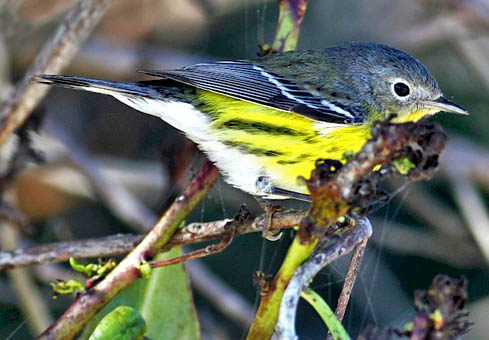
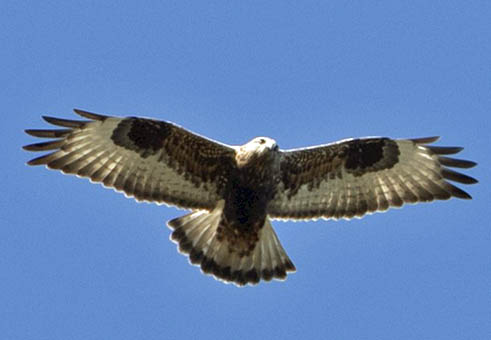
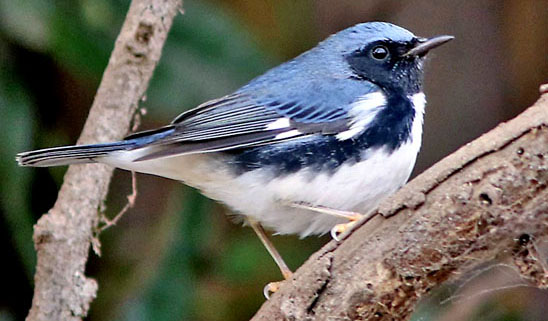
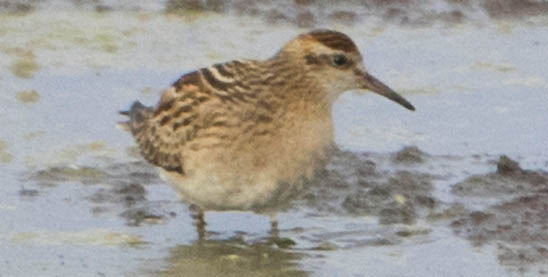
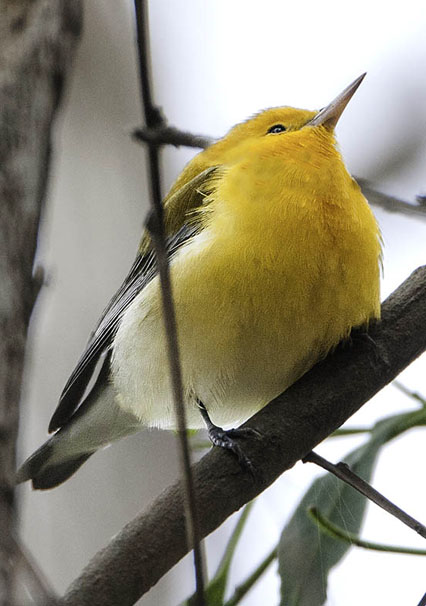
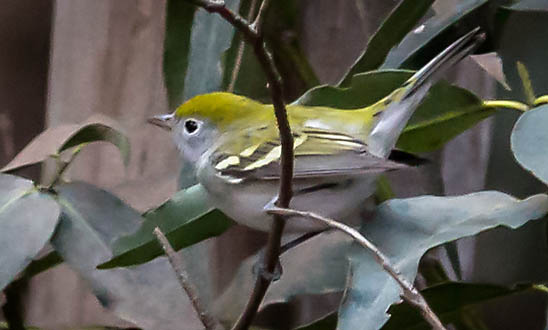
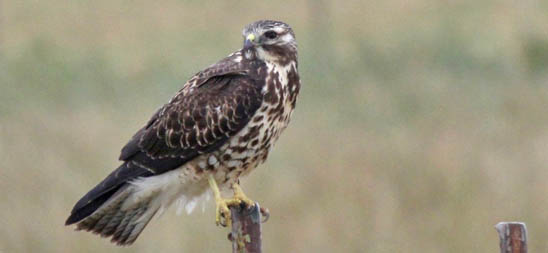
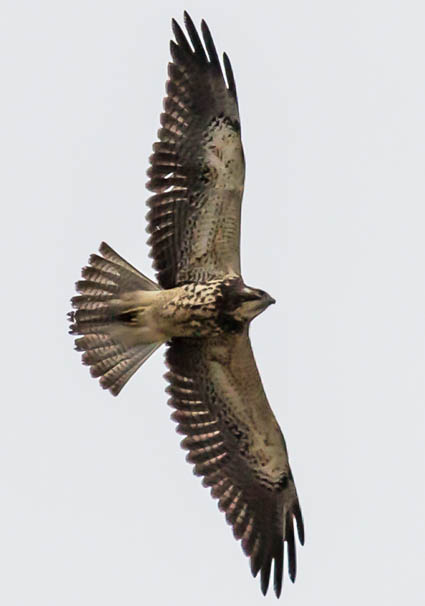
 The
Soberanes Fire, which began on 22 July in Garrapata SP from an illegal
campfire, and dominated the news in late summer, was 'officially'
extinguished on 13 October after burning 132,127 acres of the Los
Padres NF. Many State Parks and all of the National Forest continued to
be closed into October. It will be interesting to see how birds
recolonize this huge area.
The
Soberanes Fire, which began on 22 July in Garrapata SP from an illegal
campfire, and dominated the news in late summer, was 'officially'
extinguished on 13 October after burning 132,127 acres of the Los
Padres NF. Many State Parks and all of the National Forest continued to
be closed into October. It will be interesting to see how birds
recolonize this huge area.